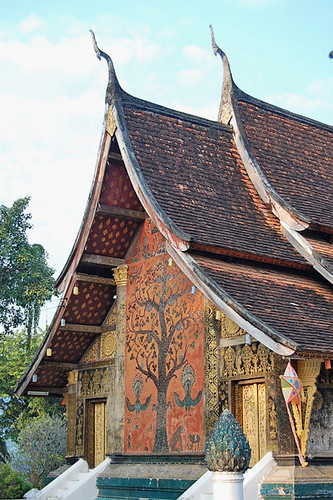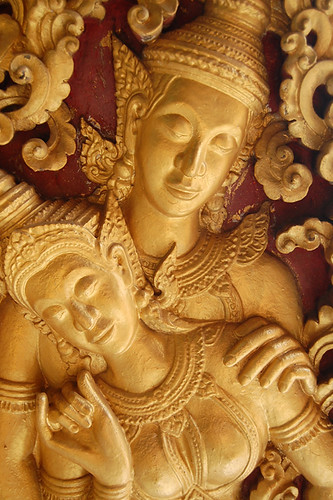We traveled here for four days: my wife and the girls plus my wife’s mom and husband, visiting from America. It was the last leg of their three-week visit to Southeast Asia and it didn’t disappoint.
Speaking with Andrew, the owner (who’s originally from Melbourne) he told me that one reason Luang Prabang has managed to retain its soul is that the people here are so proud of their culture, that they work hard to preserve it.
It shows. It’s a walkable town, although it’s also easy to grab one of the colorful tuk tuks, those covered motorcycle trucks with bench seats that are painted in a rainbow of colors. Male monks in saffron robes pace next to flash packing tourists. It’s a strange juxtaposition of the ancient and modern.
We started with a visit to an ethnology museum, a small affair funded by western nonprofits and housed in an old French villa. Here we learned about the minority tribes in Laos and their dress and customs.
Food is an integral part of Luang Prabang’s beautiful life. Whether you’re noshing a noodle dish on the street or partaking of an elegant Laos or French dinner in a faded colonial building, it’s hard to go wrong with food here. One evening I took a class in Laos cuisine offered by Tamnak Laos restaurant. It was a revelation.
On this visit, I returned to one of my favorite sites in all of Asia: Wat Xieng Thong. This stunning temple complex dates from the sixteenth century. Bejeweled, dazzling, multifaceted: the low-roofed temple and surrounding halls are exquisite in their details.
Every square inch is covered in colorful collages that glisten and shine in the late afternoon light. Supreme of all of them is the Tree of Life, found on the back wall of the Xieng Thong temple: a triumphant blazing dazzle of a tree with a pair of adjoining blue peacocks and populated with gem-like men and birds and beasts.
In an adjoining hall is a rare bronze reclining Buddha who dates from the original temple, lying peacefully in placid slumber. On other halls, carved wooden friezes painted in gold patina, which surge with battles and flames and caressing lovers–imagine it: lovers embracing at the entry to place of worship!–godly I love this country!
Later in our visit, we hiked in the cool morning to the summit of Phusi hill, right in the center of town, where another temple awaits. As if the views of the green mountainous countryside and the confluence of the Mekong and Nam Khan rivers weren’t enough already, the temple is filled with lovely sights: little pyramids made from marigolds, banana leaf, and frangipani... And the offerings of Laos kip currency folded into delicate blossoms. Patience, slowness, and beauty.
Then there were the elephants. They were fascinating creatures, 25 to 30 years old and long trained and domesticated. We bumped and slogged along in our little wooden seats atop the lady elephants. Though the route was a bit long it was a great experience.
After the elephant, a voyage across the Mekong River, wide Mekong that meanders from some high, sacred peak in Tibet 2,700 miles down to the South China Sea. We rode in a shallow, impossibly long, blue wooden boat powered by a put-putting motor to the Pak Ou caves on the opposite shore.
Back in Luang Prabang we slowed down and enjoyed life. We pedaled bicycles, ate Nutella crepes, bargained for handicrafts, nibbled on nom cinnamon rolls, and wondered when we’d get back here after returning to Hanoi.
We’ll be back, no doubt about that.
Source: onlyok.net






0 comments:
Post a Comment